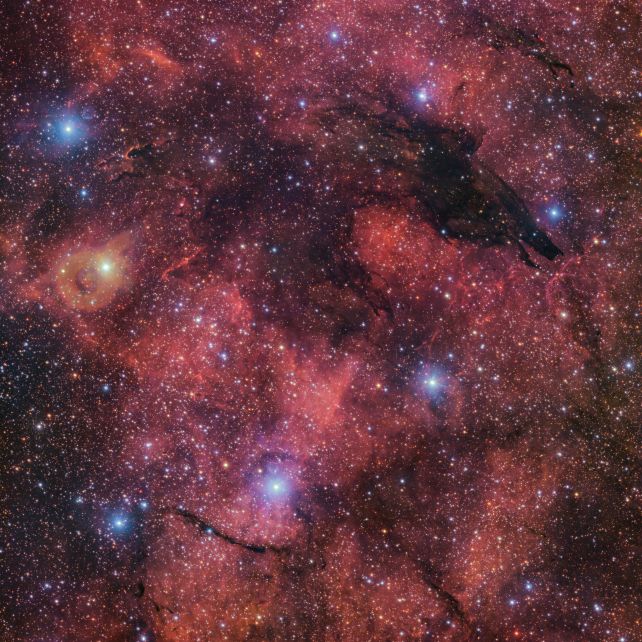ARTICLE AD
Come Ragnarök, and the end of things as we know them, according to the Norse Prose Edda, the great celestial wolf Sköll will finally catch and devour his quarry, the Sun that races daily across the sky.
Far away, in another corner of the galaxy, another cosmic 'wolf' is performing the opposite function, in spite of its appearance. The Dark Wolf Nebula, 5,300 light-years from us, resembles a dark void into which stars vanish; but this structure is the site not of star death, but star birth.
The nebula constitutes a clump of cloud in a larger complex known as Gum 55, a large region of glowing nebulosity in the southern constellation of Scorpius. It's not a void at all, but rather a concentration of material known as a dark nebula, which neither reflects nor emits visible light.
 The Dark Wolf Nebula, in Gum 55. (ESO/VPHAS+ team)
The Dark Wolf Nebula, in Gum 55. (ESO/VPHAS+ team)But dark, dense clouds are some of the most interesting objects in the Milky Way. The dust is an efficient emitter of infrared light, which carries away thermal energy and causes the cloud to cool. Without the outward pressure supplied by heat, gravity overwhelms the clumps of dust and gas and forces them together.
These are the seeds of baby stars – dense patches of gas and dust that gravitationally slurp up material from the cloud around them, gaining enough mass to generate the pressure and heat needed to ignite nuclear fusion in their core.
As the stars grow and evolve, they'll start to blast away the cloud around them through intense radiation and protostellar winds; but the very first stages of their formation process take place under the cover of darkness.
frameborder="0″ allow="accelerometer; autoplay; clipboard-write; encrypted-media; gyroscope; picture-in-picture; web-share" referrerpolicy="strict-origin-when-cross-origin" allowfullscreen>
This makes it difficult for us to study how stars are born – but not entirely impossible. Infrared instruments like JWST are able to observe wavelengths of light that can travel through dense clouds of dust with a minimum of scattering, peering inside the dark molecular clouds to the star formation within.
But visible-light images, such as this one of the Dark Wolf Nebula taken using the VLT Survey Telescope, can reveal other information about the cloud and its environs. It takes observations across the entire range of wavelengths to gain a comprehensive understanding of the places where stars are born.
And, of course, it's images like this that reinforce the circle of star life. The great sky wolf may taketh away; but the great sky wolf, in its great bounty, may also giveth to the mysteries of the cosmos, and our learning thereof.
You can download wallpaper-sized versions of this image from the ESO website.

 2 months ago
19
2 months ago
19 

